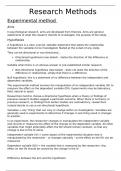Research Methods
Experimental method
Aims
In psychological research, aims are developed from theories. Aims are general
statements of what the research intends to investigate, the purpose of the study.
Hypotheses
A hypothesis is a clear, precise, testable statement that states the relationship
between the variables to be investigated. Stated at the outset of any study.
They can be directional or non-directional…
Directional hypothesis (one-tailed) – states the direction of the difference or
relationship
Suitable when there is an obvious answer or pre-established similar research.
Non-directional hypothesis (two-tailed) – does not state the direction of the
difference or relationship, simply that there is a difference
Null hypothesis: this is a statement of no difference between the independent and
dependent variables.
The experimental method involves the manipulation of an independent variable (IV) to
measure the effect on the dependent variable (DV). Experiments may be laboratory,
field, natural or quasi.
Researchers tend to choose a directional hypothesis when a theory or findings of
previous research studies suggest a particular outcome. When there is no theory or
previous research, or findings from earlier studies are contradictory, researchers
instead decide to use a non-directional hypothesis.
Variables = any ‘thing’ that can vary or change within an investigation. Variables are
generally used in experiments to determine if changes in one thing result in changes
to another.
In an experiment, the researcher changes or manipulates the independent variable
and records or measures the effect of the change on the dependent variable. All other
variables that might potentially affect the DV should remain constant, so that any
change is due to the IV alone.
Independent variable (IV) = some aspect of the experimental situation that is
manipulated by the researcher – or changes naturally – so the effect on the DV can be
measured.
Dependent variable (DV) = the variable that is measured by the researcher. Any
effect on the DV should be caused by the change in the IV.
Difference between the aim and the hypothesis:
,– a hypothesis is operationalised, clear and scientific, and can be (non-/)directional
– aim sets out general idea
Writing hypotheses accurately: include scenario + operationalised variables
Levels of the IV
In order to test the effect of the IV we need different experimental conditions.
There are two levels of the IV:
1. The control condition
2. The experimental condition
Operationalisation of variables
Operationalisation = clearly defining variables in terms of how they can be measured.
Research Issues
Extraneous variables
Any other variables that might interfere with the IV/DV should be controlled or
removed. These additional, unwanted variables are called extraneous variables and,
where possible, are identified at the start of the study.
Extraneous variable = any variable, other than the IV, that may affect the dependent
variable if it is not controlled. EVs are essentially nuisance variables that do not vary
systematically with the IV.
They do not confound the findings of the study, only make it harder to detect a result.
Methods of controlling EVs:
Matched pairs method
Standardisation
Randomisation
Confounding variables
Confounding variables do change systematically with the IV.
Confounding variables = a kind of EV but the key feature is that a confounding
variable varies systematically with the IV. Therefore we can’t tell if any change in the
DV is due to the IV or the confounding variable.
Demand characteristics
Participants are not passive within experiments and are likely to be spending much of
their time trying to make sense of the situation they are in.
So, participant reactivity is a significant extraneous variable in experimental research
and one that is very difficult to control.
,In a research situation, participants may try to work out what is going on, using
certain clues/cues called demand characteristics of the experimental situation and
may help a participants to guess the experimenter’s intentions and aims of the study.
Participants may also act in a way that they think is expected and over-perform to
please the experimenter (the please-U effect), or may deliberately under-perform to
sabotage the results of the study (the screw-U effect). Either way, participant
behaviour is no longer natural – an extraneous variable that may affect the DV.
Demand characteristics = any cue from the researcher or from the research situation
that may be interpreted by participants as revealing the purpose of an investigation.
This may lead to a participant changing their behaviour within the research situation.
Investigator effects
Participant reactivity also leads to investigator effects.
Investigator effects = any effect of the investigator’s behaviour (conscious or
unconscious) on the research outcome (the DV). This may include everything from the
design of the study to the selection of, and interaction with, participants during the
research process.
So investigator effect refers to any unwanted influence of the investigator on the
research outcome. As Hugh Coolican (2006) points out, this can include expectancy
effects and unconscious cues e.g. actions of the researcher in study’s design such as
selection of participants.
Leading questions are discussed in relation to eyewitness testimony – investigator
effects.
Randomisation
Randomisation = the use of chance methods to control for the effects of bias when
designing materials and deciding the order of experimental conditions.
e.g. randomly ordering words in a list
Standardisation
Standardisation = using exactly the same formalised procedures and instructions for
all participants in a research study.
Standardised instructions, for example, can be read to each participant.
Such standardisation means that non-standardised changes in procedure do not act
as extraneous variables.
Why do participants do better the second time they do the task? Practice effects!
Experimental designs
Experimental design means the way in which participants are arranged.
Experimental design: the different ways in which participants can be organised in
relation to the experimental conditions.
, Independent groups: when participants are allocated to different groups where each
group represents one experimental condition.
The performance of the two groups would then be compared.
- Participants who occupy the groups are not the same in terms of participant
variables – may act as a confounding variable, reducing the validity of the
findings
o To solve: random allocation and randomisation
- Less economical as each participant only contributes one result – twice as many
participants would be needed as in repeated measures, increasing time and
money needed
Order effects are not an issue
Participants are less likely to guess the aims – reduces chance of demand
characteristics
o To solve: single blind and standardisation
Same test can be used with lots of different people
Repeated measures: when all participants take part in all conditions of the
experiment.
The performance of participants in each condition would then be compared.
- Order effects (confounding variable), due to:
o Boredom or fatigue during the second task causing deterioration in
performance
o Participant performance may improve due to practice effects, especially
on a skill-based task
o Continuing effects e.g. if medicine administered in first task
o To solve: counterbalancing
- Change of equipment/tests could be an EV
o To solve: make all tests the same
- Demand characteristics – more likely that participants will work out the aim of
the study as they experience all conditions
o To solve: standardisation and a single blind procedure
Participant variables are controlled, so higher validity
Fewer participants needed, saving time and money
Matched pairs design: when pairs of participants are first matched on some variables
that may affect the dependent variable. Then one member of the pair is assigned to
Condition A and the other to Condition B.
This is an attempt to control for the confounding variable of participant variables and
often necessitates the use of a pre-test if matching is to be effective.
As they take part in only one condition: order effects and demand
characteristics are less of a problem
o To solve demand characteristics further: single blind
Participant variables reduced
Same test and equipment can be used with both groups
- Participants can never be fully matched
o To solve: pilot study to match possible EVs
- May be time-consuming and expensive, particularly if a pre-test is required, so it
is less economical





